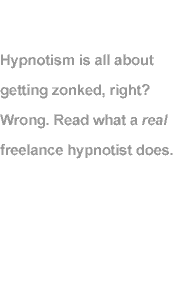 |
|
||||||||||||

|
|
|
By Andrea C. Poe
|
Sit back. Relax. Breathe. Think of the word "hypnotist": what does it conjure up for you? A magician with oil-slick hair and a pencil mustache? A pendulum dangling before your eyes? The phrase, "You're getting sleeeeeepy"? If so, you obviously haven't met Pat Lavin. A statuesque former model in her late 50s, Lavin has a lilting voice and a disarmingly calm manner. With her long, dark blonde hair and flowing clothes, she looks like one of Stevie Nicks' back-up singers. She's the new face of hypnotism. Going Pro Lavin came to hypnotherapy in an unusual way. Her interest first began in childhood, when her freethinking mother used to get books on hypnotherapy and practice techniques on Lavin and her sisters. "It never seemed weird to me because I learned about hypnosis at very young age," she says. "It's something I've used all my life for all kinds of situations, from childbirth to dental appointments." It wasn't until later in her life that she began to use her knowledge professionally. Prior to becoming a hypnotherapist, Lavin worked as an advertising copywriter, a bonsai tree salesperson, and a legal secretary. Then, about ten years ago, she sat in on a weekend hypnotherapy training course with a friend. That's when her career path became clear to her. "I realized that becoming a hypnotherapist would employ all my skills and interests," she says. Lavin then pursued several hypnotherapy training programs and received her certification. Starting out with one classified ad in the paper, Lavin's business began modestly. "I was shocked when someone called the first time," she says. Of course she was shocked; hypnotism has a rather iffy reputation. Protecting Her Rep "Thanks to TV and movies, there are a lot of myths about hypnotism and hypnotists," she says. "I tell people to forget anything they've heard. Hypnotism is simply the quieting of the conscious mind. Hypnotists help you get to that place and then give suggestions to help you visualize what it is you want to accomplish."
Which is to say, Lavin spends almost as much time dispelling the myths about her service as she does selling them. And just what are these fabled myths? Myth Number One: hypnotists need silly props. Lavin: "Candles, capes, wands, and watches don't have any magic powers in them. Anything can be used. You could use a thumbtack or put a dot on the wall. The idea is to distract the person's attention away from his or her consciousness." OK, Myth Number Two: some people just can't be hypnotized. "I've never met anybody who couldn't be hypnotized. I've only met people who wouldn't be," she says. All right. Myth Number Three: hypnotism makes you do things you wouldn't ordinarily do. Not true, she says. "I can't make you cluck like a chicken unless you want to cluck like a chicken," she says, noting that stage hypnotists who "make" people cluck like chickens are working with a self-selecting population, "individuals from the crowd who are exhibitionists -- highly suggestible people who want to please." Lavin is on a mission to let people know that hypnotherapy isn't magic or quackery. She laments that the field remains largely misunderstood and underutilized, acknowledging that clients usually come to her when all else has failed. "People tend to use hypnotherapy as a last resort, which is a shame because they could be feeling better a lot sooner if they thought of it earlier," she says. All in a Day's Work Like many IPs, a typical day for Lavin is varied and busy. On this day in mid-January she's pulled in many directions. She fields phone calls, sets appointments, gives an interview, and prepares for her upcoming seminar with the Insurance Underwriters of America. Finally, in late afternoon, she breaks for a nap. "It's all craziness," she says, exhaustion lacing her voice. "But this is the great thing about working for yourself -- you can take time off when you need to." Today, Lavin is largely running on adrenaline. She recently sealed a deal to offer her services through a local health and beauty spa, a partnership that isn't as odd as it first might seem. According to Lavin, hypnotherapy de-stresses the face, adds moisture to the skin, improves circulation, and reduces the appearance of wrinkles and lines. "It's an instant facelift," she notes, admitting that it only lasts a few hours. "But, hey, it can get you through an important evening." Unlike many hypnotherapists who specialize in one area, such as smoking cessation or weight loss, Lavin is a generalist who welcomes what she calls hypnotherapy's "limitless applications." She acknowledges that specialists generally make more money, and suggests that perhaps it's because there are fewer of them. As a generalist, Lavin faces far more competition than, for instance, a hypnotist who works exclusively with golfers (yep, you read right: a hypnotist for golfers). Word spreads more quickly in a smaller community than it does among the public at large, she explains. Most successful IPs report that they get most of their business through referrals from other clients. But that isn't always true. Although Lavin gets referrals, there aren't enough of them to keep her business afloat. "I have to keep generating business from scratch," she says. "After the five or six sessions with one client are through, I have to start up all over again looking for a new client." However, she feels that the hardships of being a generalist are outweighed by the no-doze factor. "It's just plain interesting to work with all kinds of people," she says. "I'm never bored by work, and rarely do I deal with the same situation twice." Lavin is part of the first wave of hypnotherapists that has begun to have an impact on the workplace. She regularly coaches corporate groups on the benefits of hypnotherapy. "Stress is a major problem in our culture. We used to have lunch breaks and time off -- now people are constantly working. You can bring in all the gung-ho motivational speakers you want, but nobody is going to be any good at their jobs without balance in their lives," she says. Lavin teaches corporate groups self-hypnosis so employees can practice what she calls "five-minute hypno-vacations" when they're stressed. "Even a few minutes of relaxation restores focus, and makes you ten times more productive afterwards," she maintains. Though she's worked with groups as large as 200, Lavin works primarily with individuals. "On a good day I see five people," she says. That may mean hopping in her car and making house calls or it may mean a mad last-minute scramble to clean her house before clients come over. She Doesn't Judge Lavin says the reasons people seek out her services are as varied as the people themselves. She has worked with everyone from a man preparing for a sex-change operation to a man obsessed with brushing his teeth to a woman who wanted to overcome her fear of singing. "Nothing is too unusual for me," she adds. "I don't judge. My job is to get them where they want to be."
The wackiest calls for help come from people who want to change other people, she reports. "I'll get a call from someone saying, 'I want my girlfriend to fall madly in love with me. Let me bring her over -- I'll pay for the session and you make it happen,'" Lavin laughs. "I have to explain to them that I can't make people do things they don't want to do. I only help them unlock their subconscious." Taking the Show on the Road Though she advertises in local papers and posts flyers in her community, most of Lavin's work comes by word of mouth. An avid lecturer, Lavin speaks to civic and business groups several times a month. She also teaches seminars at The Seminar Center in Manhattan and writes about issues in the field of hypnosis for The Seminar Center Magazine. This high visibility has garnered her national attention. She has demonstrated hypnotherapy techniques on a variety of radio and television programs, including National Public Radio and The Maury Povitch Show. So, when she goes on these shows to discuss her occupation, do the hosts -- or the audience -- ever look askance? "Less and less so, thankfully," she says. "Hypnotherapy is becoming more accepted as more people become acquainted with it and as more hypnotists become certified." Despite her spate of high-profile publicity gigs, she still maintains a humble, client-friendly manner. "I am not an authoritarian. I don't want to have power over people," she says. "I see myself as a coach. My job is to empower people, and that's a pretty great way to make a living." |
|||||||||||||||
|
May 8, 2000 Primary Editor: Ken Gordon Illustrator: James Stringer Production: Fletcher Moore |
We'd love to hear your comments about this article! Andrea C. Poe is a freelance writer who lives in Easton, Md. If you like, we'd be happy to put you in touch with her, or with anyone named in this article. | |||||||||||||||
|
| ||||||||||||||||
